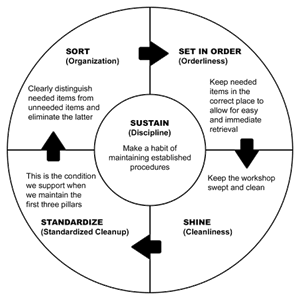5S Implementation Strategy
5S Implementation Strategy
By Patrick Detroit
I was talking to a friend the other day and he was mentioning a conversation he had with a client concerning the 5S’s. The client said that they’ve tried it a few times but it never stuck. I quietly went home and started thinking about the 5S’s and began asking myself some questions. The first question we always ask is “why,” so I started there. Not just each iteration in the 5S system but why 5S’s? Why not 5T’s or 5W’s?
What I realized, as with any translation, some of the meaning or intent is lost. The English words used for the 5S’s might not be the best words to describe the concepts to use to properly apply the system.
Here are the definitions I found via the Merriam-Webster dictionary and the Denshi Jisho online Japanese dictionary:
Sort – the act of separating things and putting them in a particular order
整理 (Seiri) – sorting; arrangement; organization; putting in order; adjustment; regulation; liquidation
Straighten - to make (something) organized or tidy
整頓 (Seiton) – orderliness; put in order; tidying up; arranging neatly
Shine – to make bright by polishing
清掃 (Seiso) - cleaning
Standardize - to bring into conformity with a standard
清潔 (Seiketsu) - pure; virtuous; immaculate
Sustain – to provide what is needed for something or someone to exist, continue, etc…
躾 (Shitsuke) discipline; training; teaching manners
1. With this in mind I started thinking about what I do when I facilitate a 5S project. The first step “Sort” always reminded me of getting ready for a garage sale. The family is going through everything and asking questions like this:
- What is this thing?
- What the heck do you use this for?
- Do we really need this thing?
- Can we sell it?
- How much do you think we can get for it?
- Should we give it away or just trash it?
- If we’re going to trash it, can it be recycled instead?
So with this garage sale mentality that I’ve had, what have I done to facilitate a 5S? I’ve done what I always do when I “Sort” but I sell it differently to the team that is doing the work. If you asked me to do a garage sale at work, I’m all in! If you ask me to sort through everything we have at work, well, I might just look at you like “You want me to do what?”
2. What I think is lost with “Straighten” may be the orderliness portion of it. When we organize and tidy up it’s different than instilling orderliness. To me organized and tidy means an area or system looks efficient and the mess is put away. This is important, but I have to tell you when I was ten, putting the mess away meant shoving everything under my bed. It took a Sorting event (parent intervention) for me to control the mess in my room. After that my parents instilled an ideal of what order is. So with this iteration in the 5S tool I openly talk to the team about supporting the project and having one voice outside the workspace. Part of your ground rules should be to thoroughly discuss (sometimes argue) behind closed doors but don’t let it leave the room. One voice and one message once the doors open. If someone from another department asks “What are you guys doing over there?” every team member should have the same answer. If one person says, “I really don’t know and I don’t like it,” it will undermine your position, the team’s success, and could ruin it for the next department that may utilize a 5S. When you have lateral alignment in the team’s voice, it starts to instill team unity and discipline to maintain the orderliness of the completed project.
3. “Shine” is pretty straight forward. Let’s get things clean so we can see what we missed or what needs fixing. Now the word “cleaning” can have a bad connotation to some people. So why not call it something else, I personally like to call it Attack Mode, it makes it a little fun and anything you can do to get people motivated is going to help. An example of this was at a recycling center. Once everything was cleaned up we noticed a leak in one of the hydraulic pumps that was mounted on top of a compactor about 15 feet in the air. The seal they had to replace was minimal in cost to replacing the pump itself. If I didn’t send them out in Attack Mode I don’t know if the top of that pump would have been wiped off and we may not have seen the leak. The team needs to be fully vested in the project by now. If anyone finds something that needs to be fixed or corrected celebrate the individual effort and promote it as a team win. Maybe bring in a fruit basket or coffee the next morning.
4. In my mind the meaning of “Standardize” is extremely different than pure, virtuous, or immaculate. The way I reconcile the two definitions is to believe that standardization is how we see our end state of the system, office, workshop, etc… that we just finished implementing. We and the team may think that what we just did is absolutely perfect. Let them know that there will be things they may see that need to be tweaked and optimized in the future and that it’s their responsibility to bring it up to management. I normally formalize the project outcomes and ground rules for future improvements with a written document (5S contract) signed by everyone on the team and forwarded to management. I let every team member have a say so or be responsible for part of the document so you have their buy in. This helps management in the next step of the process.
5. Sustain, I believe, is where most 5S projects fail because keeping something alive, is different than discipline, training, and teaching manners. When I think of keeping something alive, I think of the basic sustenance needed for survival. When I think of discipline and training, well, I think of management. Many managers may have heard of or used 5S before and have seen it fail because it wasn’t made part of their daily routine. This is where you as the facilitator or project lead need to sell this to management as a leadership discipline. Give them the inspection sheets for the check offs, make it a priority for them. Their team did all this work and for it to succeed, they have to hold them accountable to what they signed on for in the 5S contract.
So with all this being said, 5S works, but as LEAN practitioners we’re always looking for better ways to do everything and anything. So if you run into someone who is resistant to 5S call it something else. How about the Guinness Optimization and Leveraging Development Program (GOLD Program). I just made that up, but you get my point. I only offer this as another way of framing 5S.
This is how I capsulate a 5S:
- Garage sale (Sort)
- Orderliness (Straighten)
- Attack mode (Shine)
- Purity (Standardize)
- Discipline (Sustain)
I offer this as an alternative thought to 5S implementation. It has produced positive results for me in the past; I hope you may find it useful.
Recent Updates
Microsoft Outlook Add-In

Focus on Your Life, Not Your Inbox
Achieve greater focus by shifting your attention from e-mail to accomplishing what matters most!
Company News
Stay up to date with our newsletter!



